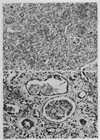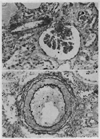RENAL HOMOTRANSPLANTATION; LATE FUNCTION AND COMPLICATIONS
- PMID: 14218932
- PMCID: PMC2977918
- DOI: 10.7326/0003-4819-61-3-470
RENAL HOMOTRANSPLANTATION; LATE FUNCTION AND COMPLICATIONS
Figures
















References
-
- Murray JE. Human kidney transplant conference. Transplantation. 1964;2:147. - PubMed
-
- Starzl TE. Transplantation of the Kidney. Philadelphia: W. B. Saunders Co.; 1965.
-
- Hume DM, Magee JH, Prout GR, Jr, Kauffman HM, Jr, Cleveland RH, Bower JD, Lee HM, Kramer N. Studies of renal transplantation in men. Ann. NY Acad. Sci. In press. - PubMed
-
- Hamburger J, Crosnier J, Dormont J. Observations in patients with a well tolerated homotransplanted kidney: possibility of a new secondary disease. Ann. NY Acad. Sci. In press. - PubMed
MeSH terms
Substances
Grants and funding
LinkOut - more resources
Full Text Sources
